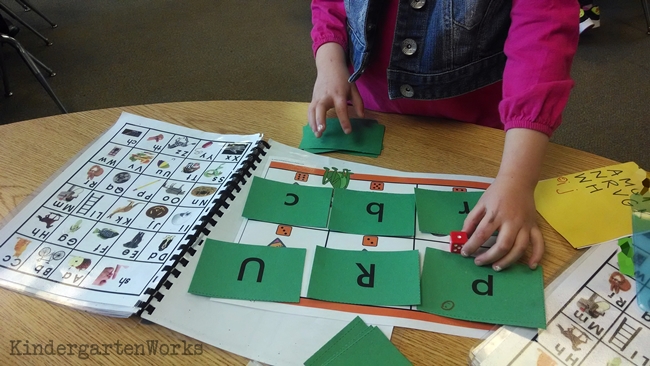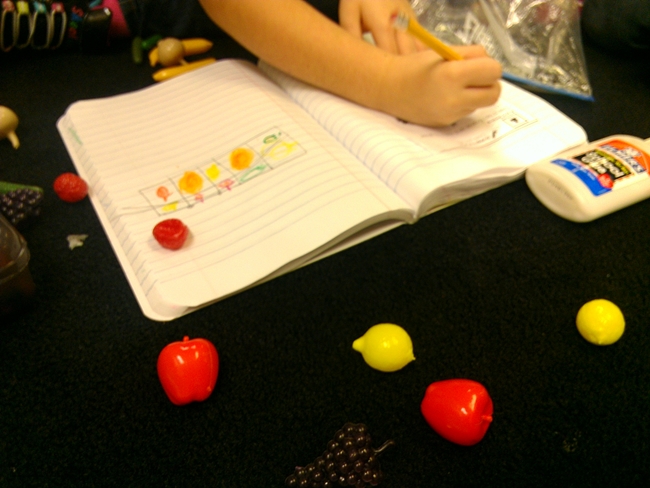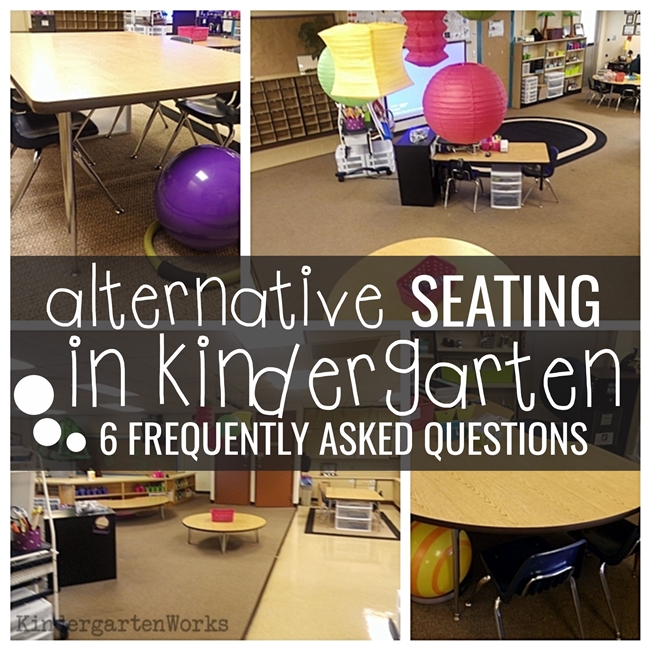Flexible Seating: Your Kinders are Under the Tables!
Now, I’ve never had an administration member, parent or support person walk into my room and say astonishedly, “Your kids are under the tables!” But, they very well could.
It may happen someday.
Perhaps.
Normally, when a person who doesn’t spend all day in our learning environment with us – may be surprised to walk in and see kinders essentially everywhere. I usually see surprised smiles or second glances at what doesn’t fit their expected view of a classroom life.
What they may see is kinders standing, sitting, kneeling, laying, balancing or even walking but they are learning. You’ll see a variety of working options that I like to think of as “alternative seating.” Others call it flexible seating.
{Well, okay so I’d lie if I said every student was 100% on task 100% of the time since we know that’s not even possible to attain as adults. But, we are all engaged and don’t ever stray too far from the task at hand.}

See that kinder under the table? It’s a valid workspace.
And why not? As long as a student can handle the responsibility of it, I’m totally cool with it.
And they love it.
With increased freedom, comes enhanced satisfaction and motivation. I see that students grow in maturity rapidly when they begin to make learning choices that are in their best interest and are given the chance to make those choices.

Here is a glimpse across my classroom at literacy centers when I am meeting with small groups on differentiated reading instruction.
Students often use shelves for standing spaces to work.

Students sit, just like any classroom.
But with flexible seating, they also can create their own seated spaces. Sometimes they find a little niche I never thought of or pull seating together to make their own spot for reading or working.

The floor is such a popular choice, as I’m sure with any kindergarten classroom.
We encourage working from the stomach since it strengthens the core. I see that it helps strengthen fine motor muscles over time too when they are drawing, writing or working from the floor too.
I’m not an OT, it’s just what I’ve seen!

I teach a huge portion of my day in small groups. I teach both guided reading and guided math which means my students are regularly making their own choices about where and how to work best.
This one above chooses to push in the chairs I have at the teacher table consistently before beginning a task that feels game-like.
Here is a glimpse across a few students working during math time over a few years. My classroom layout may change from year to year, but the freedom and responsibility to choose workspaces remains.
I’ve done this ever since I was maxed out on creativity when I started teaching math in small groups.

Kneeling is our seating option at the teacher zone since this table is lowered to the floor.
Some students really struggle with this, especially if they are more *impulsive* but I like the variety it offers.
I too sit on the floor when working with groups at this table.

Students pull up chairs as needed if there aren’t any, enough or if they are desiring to have a chair at random location. We’ve incorporated putting chairs back into our clean up procedures.
It just had to be taught, the same as pushing chairs in.
Below, you’ll see more work being done on the carpet. It’s always a favorite during math time.

So, do my kinders spend all day under the tables?
Nope.
Do they choose a ball chair or standing space every time?
Nah.
I have 3-4 kinders every year who settle into one type of preferred seating, especially those that are standers! They really seem to recognize that in themselves.
I find that the rest of my students will vary their choice upon the type of activity and also proximity to getting out/cleaning up materials. You’ll see that especially during art or guided drawing projects, students will stand.
It just lends itself naturally since they are reaching materials, putting materials away or cleaning at various stages as they work. This project was all about exploring texture in abstract art, so it was very messy and required lots of materials.

While I’ve yet to hear someone exclaim, “Your kids are under the tables!” {wink} I look forward to continue on exposing those that come in with surprised looks on just how productive we can be even when we don’t “look” like the typical classroom.
The more time people spend with us, the more flexible seating begins to look normal and they are able to see past some of the ‘unconventional’ and see the learning going on right in front of their eyes.
Want to find how to make this happen in your classroom too?
You’ll get my best on making the most of your classroom and be on your way to making it happen!







Hi Leslie,
Thanks so much for this fantastic info on alternative seating. I’m giving it a shot this year! Could you tell me what you used on the bottom of the table legs (the lowered tables) to protect the carpet? Our custodial staff said I need to do tennis balls, but was just wondering if there are other options.
Hi Nancy,
We used the regular table legs just at their lowest setting – and my custodian may have tapped in the normal bottom feet to protect the floor in those legs for me… but I bet tennis balls would work to make it happen for you! Good luck this year trying something new!
Just wondering how you handle eating times. I use flexible seating but have kept enough traditional table seating for snack and lunch time. Would love to create some more space by getting rid of more tables.
Hi Lisa, we didn’t have lunch in our rooms (nor regular snack either) but when we did have a birthday treat – they simply had it at one of the tables (sitting or kneeling) or standing spaces. It worked for us. Not sure how I’d feel about standing spaces for lunch – I’d probably have them opt for the regular height tables w/ chairs or low tables and kneel/sit criss cross.
I want to do alternative seating in my kindergarten classroom next year. How do you start the year? I am trying to wrap my brain around how I would get started. They all start at desks and add choices gradually? Have everyone try out the different options? Explain it all at the beginning and let them choose right away? Could you walk me through how you start it all? Thank you!!
Hi Julie,
I’ve started both at the end of a school year and at the beginning. Here are my top tips on rolling out such a system with new kinders! https://www.kindergartenworks.com/classroom-setup/roll-student-work-spaces/ Hope it can help!
– Leslie
I want to have fewer tables in my room and more floors space for my minders to work. I have raised 2 tables for those who like to stand. My principal says she wants information stating that this is appropriate for kdg. She is worried sitting on the floor will develop poor posture in writing. I need strong resources providing that my idea is developmentally appropriate. Can someone help me.
Hi Tammy,
I can understand that sometimes there are barriers to overcome. Way to go on having standing spaces already in place! I had 3 kids last year who stood for EVERYTHING! They never chose a sitting space…. ever! Normally mine who write on the floor aren’t usually just sitting… unless it’s during our whole group time. No matter when, they always can have clip boards or lap boards to sit however is most comfortable for them. I usually seem students lying down when writing. I’ve been told by my school’s occupational therapist that writing while laying on the tummy (supporting oneself with both arms) is very good for strengthening core muscles which leads to lots of other good things. If you have an oocupation therapist in your district, it’s totally worth a conversation with them. They might be able to think of things that can really help or have documentation to satisfy your principal. Remember that I always offer it as choice! Hope that can help point you in the right direction.
– Leslie
Hi, could you please tell me the name of the big bug book that your student is reading.
Hi, I don’t remember right now. It’s actually about animal babies if I recall correctly.
– Leslie
Hi Leslie, I’ve been following you for quite a while now and always resonate with what you’re talking about. Giving kids the opportunity to move, sit, and stand in different ways is so important to learning. I love seeing your pics of how you do it. I give these same options to my kidpeople and have a couple other ways I incorporate movement, too– one is standing centers that incorporate rocker and balance boards, logs, etc. The other is Motor Kids– a variation on Motor Moms and Dads. You can see my pics and read about how I do it on these two posts. I hope you enjoy and I hope to hear back from you 🙂 Kathleen at KidpeopleClassroom
http://www.kidpeopleclassroom.com/2014/02/weve-got-to-move-it-move-it-standing.html#more
http://www.kidpeopleclassroom.com/2014/02/weve-got-to-move-it-move-it-motor-kids.html
Thanks Kathleen for sharing how you incorporate options into your classroom! Love it! I’ll be by to read your blog for sure.
-Leslie
“I see that students grow in maturity rapidly when they begin to make learning choices that are in their best interest and are given the chance to make those choices.”
Love it!
Great point Sandi! It’s totally true and you can see who are the most mature right of the best since they have an easier time choosing wisely right from the start.
– Leslie